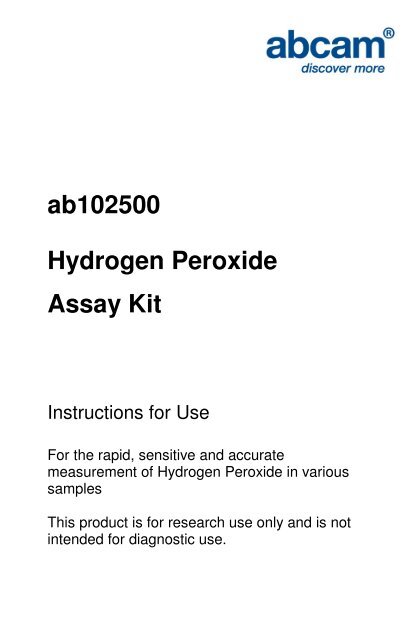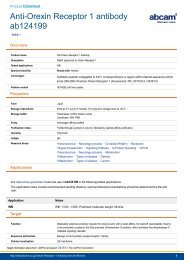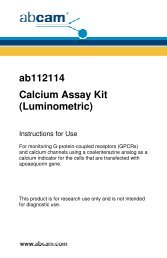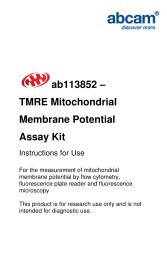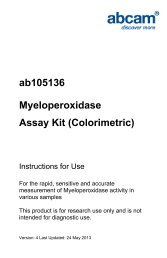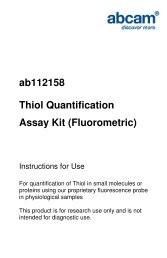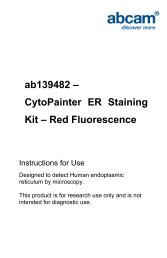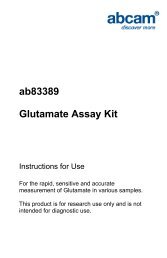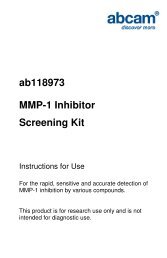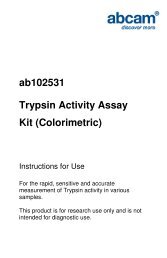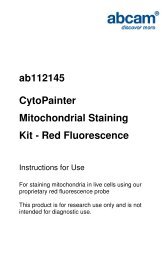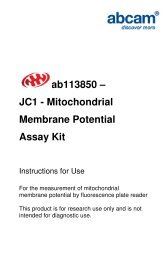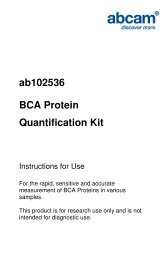ab102500 Hydrogen Peroxide Assay Kit - Abcam
ab102500 Hydrogen Peroxide Assay Kit - Abcam
ab102500 Hydrogen Peroxide Assay Kit - Abcam
Create successful ePaper yourself
Turn your PDF publications into a flip-book with our unique Google optimized e-Paper software.
<strong>ab102500</strong><strong>Hydrogen</strong> <strong>Peroxide</strong><strong>Assay</strong> <strong>Kit</strong>Instructions for UseFor the rapid, sensitive and accuratemeasurement of <strong>Hydrogen</strong> <strong>Peroxide</strong> in varioussamplesThis product is for research use only and is notintended for diagnostic use.
2. Protocol SummarySample PreparationStandard Curve PreparationPrepare and Add Reaction MixMeasure Optical Density or Fluorescence4
3. Components and StorageA. <strong>Kit</strong> ComponentsItemQuantityH 2O 2 <strong>Assay</strong> Buffer25 mLOxiRed Probe Red1 vialDimethylsulfoxide (DMSO, anhydrous) 400 µLHRP1 vialH 2O 2 Standard (0.88M) 100 µL* Store kit at -20°C, protect from light. Warm the <strong>Assay</strong> Buffer toroom temperature before use. Briefly centrifuge all small vials prior toopening. Read the entire protocol before performing the assay.OxiRed PROBE: Dissolve in 220 µl DMSO (provided), pipetting upand down. The OxiRed Probe solution is stable for 1 week at 4°Cand 1 month at -20°C.HRP: Dissolve in 220 µl assay buffer, pipetting up and down. TheHRP solution is stable for 1 week at 4°C and 1 month at -20°C.5
B. Additional Materials Required• Microcentrifuge• Pipettes and pipette tips• Fluorescent or colorimetric microplate reader• 96 well plate• Orbital shaker6
4. <strong>Assay</strong> Protocol1. Sample Preparation:a) Collect cell culture supernatant, serum, plasma, urine and otherbiological fluids (contains 0.8-6 µM H 2 O 2 ).b) Centrifuge for 15 minutes at 1000 x g within 30 minutes ofcollection. Remove particulate pellet.c) <strong>Assay</strong> immediately or aliquot and store the samples at -80°C.Avoid repeated freeze-thaw cycles.d) Add 2-50 µl samples into each well; bring the volume to 50 µl withassay buffer.2. Standard Curve Preparation:a. For the colorimetric assay:Dilute 10 µl 0.88M H 2 O 2 standard into 870 µl dH 2 O to generate10 mM H 2 O 2 standard, then dilute 10 µl 10 mM H 2 O 2 standardinto 990 µl dH 2 O to generate 0.1 mM H 2 O 2 standard.Add 0, 10, 20, 30, 40, 50 µl of the 0.1 mM H 2 O 2 standard into96-well plate in duplicate to generate 0, 1, 2, 3, 4, 5 nmol/wellH 2 O 2 standard.7
MethodsWork-related traumatic fatalities involving emergency service workers in Australia werestudied as part of a larger study of all work-related traumatic fatalities that occurred inAustralia during the four-year period 1989 to 1992 (WRFS 2). This was the second of twostudies of work-related traumatic fatalities that have been conducted by the NationalOccupational Health and Safety Commission (NOHSC). The first of these studies coveredthe period 1982 to 1984, inclusive (WRFS 1: Harrison et al, 1989). The information for bothstudies was obtained primarily from coronial files. Detailed information was collected aboutthe work-related deaths. For most other non work-related traumatic deaths, a short textdescription was made of the circumstances. A general overview of the main results from thesecond study is available elsewhere (NOHSC, 1998). A summary of the methods anddefinitions used in this study is included at Appendix 1.Inclusion criteriaThis paper describes the deaths of emergency service workers and others who were fatallyinjured as a result of emergency service work. Police officers, firefighters, ambulanceofficers, Special Emergency Service workers, search and rescue workers and other similaroccupations were included.The focus of the paper is on those workers who were fatally injured as a result of their work.Since volunteer workers perform much emergency service work, volunteer emergency serviceworkers were considered to be working for the purposes of this report. However, whereappropriate, they are separately identified from the employed workers.Employed persons involved in emergency service work who were fatally injured whilecommuting are also considered in brief.Persons who were not involved in emergency work, but who were fatally injured as a result ofthe work activity of an emergency worker, are included in the report and described as‘bystanders’. However, persons deliberately injured by police officers in the course oflegitimate police work (e.g. a felon shot by police during an exchange of fire) are not includedas bystanders.In the firefighters’ section, brief mention is made of workers who were not firefighters butwhose jobs could be expected to require them to at times fight fires and who were fatallyinjured in similar incidents to the firefighters.Employed persons who would not normally be expected to be involved in emergency servicework, but who were fatally injured while performing search and rescue activity during anemergency at their work, are not included in this paper. Examples include being overcome byfumes in a confined space while attempting to rescue an unconscious colleague; and beingfatally injured in a fire while rescuing people from a burning building during a business trip.These workers were excluded because the emergency service activity was considered to beunusual for the occupations of the persons involved.2
SampleswithinconsistentreadingsLower/Higherreadings insamplesandstandardsUnsuitable sampletypeSamples prepared inthe wrong bufferSamples notdeproteinized (ifindicated ondatasheet)Cell/ tissue samplesnot sufficientlyhomogenizedToo many freezethawcyclesSamples containimpeding substancesSamples are too oldor incorrectly storedNot fully thawed kitcomponentsOut-of-date kit orincorrectly storedreagentsReagents sitting forextended periods oniceIncorrect incubationtime/ temperatureIncorrect amountsusedRefer to datasheet for detailsabout incompatible samplesUse the assay buffer provided(or refer to datasheet forinstructions)Use the 10kDa spin column(ab93349)Increase sonication time/number of strokes with theDounce homogenizerAliquot samples to reduce thenumber of freeze-thaw cyclesTroubleshoot and also considerdeproteinizing samplesUse freshly made samples andstore at recommendedtemperature until useWait for components to thawcompletely and gently mix prioruseAlways check expiry date andstore kit components asrecommended on the datasheetTry to prepare a fresh reactionmix prior to each useRefer to datasheet forrecommended incubation timeand/ or temperatureCheck pipette is calibratedcorrectly (always use smallestvolume pipette that can pipetteentire volume)12
Problem Reason SolutionStandardcurve is notlinearNot fully thawed kitcomponentsPipetting errors whensetting up thestandard curveIncorrect pipettingwhen preparing thereaction mixAir bubbles in wellsConcentration ofstandard stockincorrectErrors in standardcurve calculationsUse of otherreagents than thoseprovided with the kitWait for components to thawcompletely and gently mix prioruseTry not to pipette too smallvolumesAlways prepare a master mixAir bubbles will interfere withreadings; try to avoid producingair bubbles and always removebubbles prior to reading platesRecheck datasheet forrecommended concentrations ofstandard stocksRefer to datasheet and re-checkthe calculationsUse fresh components from thesame kitFor further technical questions please do not hesitate tocontact us by email (technical@abcam.com) or phone (select“contact us” on www.abcam.com for the phone number foryour region).13
UK, EU and ROWEmail: technical@abcam.comTel: +44 (0)1223 696000www.abcam.comUS, Canada and Latin AmericaEmail: us.technical@abcam.comTel: 888-77-ABCAM (22226)www.abcam.comChina and Asia PacificEmail: hk.technical@abcam.comTel: 108008523689 ( 中 國 聯 通 )www.abcam.cnJapanEmail: technical@abcam.co.jpTel: +81-(0)3-6231-0940www.abcam.co.jpCopyright © 2012 <strong>Abcam</strong>, All Rights Reserved. The <strong>Abcam</strong> logo is a registered trademark. 15All information / detail is correct at time of going to print.


